
Paul Sincock reflects on Plymouth and the power of positivity


Paul Sincock reflects on Plymouth and the power of positivity

Ashwin Building Company is a family-owned home building & remodeling business based in Northville, Michigan with 35 years of experience in construction, home remodeling, and contracting. Blending time-tested construction practices and design, we personally strive to provide the best services to our customers before, during, and after project completion.


Let us bring your vision to life and create a space that truly reflects your style and personality. Contact us today to begin your journey to a beautiful home!







Please consider a donation to support The Rock. Since we began publishing more than four years ago, our goal has been to provide our readers with valuable information about the Plymouth community each and every month. Your support is vital if you would like to see us survive and grow. The Rock is sent free to every address in Plymouth, yet is not free to produce.
LOCAL Matters!
That is the foundation of this magazine. If you find it of value, please consider supporting it. We need your support.
Please send donations to:
Journeyman Publishing 16435 Franklin Northville, MI 48168
You can also make donations via Pay Pal to kurtkuban@gmail.com.
Thanks in advance,

• Reach 21,000 addresses every month.
• We direct mail to every address in the 48170 zip code.
• Our locally-owned and produced publication is an affordable way for your business to reach the entire Plymouth market.
To secure space in an upcoming issue of The Rock, contact Advertising

Director Scott Buie at (313) 399-5231, or via email at scottbuie@therockmagazine.com or advertising@therockmagazine.com.











KURT KUBAN – Publisher
Kurt is an award-winning journalist, having served as a reporter and editor for several local newspapers and magazines, including the Plymouth Observer He has been a journalist for over two decades. He founded Journeyman Publishing, which also publishes The ‘Ville, in 2017.
SCOTT SPIELMAN – Editor
Scott graduated from the University of Oregon with a degree in Journalism. He covered western Wayne County for more than 12 years at several publications before transitioning into corporate communications and media relations. A Canton resident, he has also finished his first novel and is hard at work on his next.
SCOTT BUIE – Advertising Director/Vice President of Sales
Scott has 20+ years creating advertising campaigns for clients in Metro Detroit. After managing sales for radio stations for 17 years he purchased Street Marketing, where he works closely with a variety of businesses and events. Scott and his family have lived in the Plymouth/Northville area for over 23 years.
JENNY PEARSALL – Creative Director
Jenny has been in the design and print industry for over twenty years, holding various positions in graphic design, print buying, production and print management. She also owns Bovia Design Group, a company specializing in publications and corporate branding.
MICHELE FECHT – Writer
Michele is an award-winning journalist whose first post-college reporter position was at The Northville Record before moving on to The Detroit News She has been a City of Northville resident for nearly 40 years and is an author, researcher and local history enthusiast.
TIM SMITH – Writer
Tim brings a penchant for telling personal stories that run the gamut from news to sports. During more than 35 years in journalism, mostly with the Observer & Eccentric, he has earned numerous state and national awards. The Wayne State grad is a published author and rec ice hockey player.
WENSDY VON BUSKIRK – Writer
Wensdy graduated with a degree in journalism from Wayne State University. Her first job was working as a reporter for The Northville Record. Now, as a freelance writer and editor, she works for a variety of magazines, including The Rock. -Photo by Kathleen Voss
SUE VOYLES – Writer
Growing up, Sue always knew she wanted to be a writer. She has written for many publications over her long career in public relations and journalism, and taught English and journalism at Schoolcraft College. In 2022, she received the national Headliner Award from the Association for Women in Communications.
KEN VOYLES – Writer/Photographer
Ken is an award-winning writer, photographer and designer whose career has spanned nearly five decades in and around metro Detroit. He started his journalism career in Plymouth, working for the Community Crier. He is the author of two books on Detroit history, loves to travel and has finished his first novel.
BILL BRESLER – Photographer
Bill arrived in Plymouth in 1977 to work for the Community Crier. He also worked for the Plymouth Observer for many years. Bill, who taught photography at Madonna University, retired from what was left of the newspaper business in 2019 and now freelances. He’s happy to be back in the Plymouth community.
BRYAN MITCHELL – Photographer
Bryan started working as a photographer more than 30 years ago, and was a staff photographer for the Plymouth Observer in the 90s. He has freelanced for The Detroit News, The Guardian, Reuters, and other publications. His photography has appeared in newspapers and magazines around the globe.
are welcome at kurtkuban@therockmagazine.com .
With the way 2025 has flown by, the election cycle really snuck up on me. The August primary came and went without much fanfare—in the City of Plymouth, only one candidate was eliminated from a field of nine candidates seeking four commission seats. (That was former Planning Commissioner Scott Silvers, who received 435 votes, or about 7% of votes cast.) The remaining eight candidates will move on to November. Voter turnout in the city was nearly 22% which, sadly, isn't too bad for a primary.
I’d like to take this opportunity to thank all the city candidates for responding to our questionnaire quickly, so that we could get their message out to the public. I appreciate anyone willing to seek office at a time when politics in general has gone crazy.
As a reminder to long-time readers and a note to new ones, The Rock does not offer political endorsements. We think our role is to get information out to the public so they can make the most informed choice on election day. I sometimes miss the old days when writing endorsements was a part of the gig; the editorial staff would sit back, cast aside political affiliations and whether or not a particular candidate was an incumbent or not, and discuss who we, as a group, thought would best serve the community.
But let’s face it, those were different times. Nowadays, you can’t even point out an objective fact without having someone assign a label or political identity to you and threaten a boycott. (Which, again, speaks to my appreciation to anyone who runs for office in the first place). A phrase came up as I was talking with City Manager Paul Sincock for his “exit interview” (see story, page 6): You can disagree with someone, but don’t be disagreeable.
Former Commissioner Dennis Shrewsbury said that often back in the day when politics was also a bit contentious in the City of Plymouth. Sincock invoked the phrase as he remembered a time when people could do just that: talk through their differences. It’s a reminder that, particularly at a local level, politics should just be about neighbors helping neighbors, no matter what side of the aisle they fall on, and that communication is the first step toward reaching resolution.
That was a common chord that struck me as I was reading through the answers from the city commission candidates. Nearly everyone wrote that communication was, in some form, an issue to be addressed in the city. Maybe they listed it directly, maybe through phrases like improved engagement or transparency, but it was an underlying theme. I think this is fallout from a couple of issues, notably the Champion development, Brookside, and the back-to-back parks millage requests that voters rejected.
Still, it seems a bit odd to me, considering the many ways the city tries to communicate with residents. Anyone can see the meeting agendas and background on the website, watch the videos or go to the meetings—which, during the summer, take place in parks throughout the city. You don’t even have to go to city hall, and you can pack a sandwich.
There are also official social media channels for both the city and the Downtown Development Authority, as well as a host of others. Newsletters, too, and now, a recurring feature in The Rock that provides snippets of city news in addition to our regular features and stories.
It’s not that the effort isn’t there. Maybe it’s the perception that residents are being talked to instead of talked with. It’s not just an issue in our neck of the woods, it’s everywhere. It’s easy to understand that viewpoint when you’re given, for example, three minutes to talk on something that can change your quality of life or the direction of your community for the next decade. Meanwhile, the idea of listening has become just waiting for the opportunity to talk back. I’m as guilty as anyone else.
I’m not sure what the answer is, or even if I’m just over-analyzing things. But it’s something to think about going forward, in our personal, professional or civic lives. As always, I welcome your thoughts!
Scott Spielman is the editor of The Rock. He welcomes your feedback or letters to the editor at scottyspielman@gmail.com.




OFF:
Please submit your letters by emailing Editor Scott Spielman at scottyspielman@ gmail.com. Letters should be no more than 150 words. We reserve the right to edit all letters.
As a new resident to Plymouth, drawn to the community by its historic feel, I’m deeply concerned about the proposed high-density housing development near our historic downtown. We must ensure that new development aligns with the city’s Master Development Plan and respects the character of the community.
Our downtown is more than a collection of buildings—it’s the heart of our community, rich in history, architecture, and small-town charm. Introducing large-scale, high-density structures in this area risks erasing that identity. It brings to mind the old phrase: “They paved paradise and put up a parking lot.”
The city’s Master Development Plan was thoughtfully designed to promote responsible growth while preserving the integrity of our historic spaces. Disregarding that vision in favor of rapid development would be short-sighted and damaging to the long-term vitality of our community.
I urge city leaders and fellow residents to prioritize development that enhances, rather than replaces, the unique character of our community.
Marcie Johnson
Personalized service means having a financial advisor who understands you and what you’re trying to achieve, and helps to create a unique strategy based on your needs and circumstances.
Let’s start building the future today.

John A Birchler CFP® Financial Advisor
1176 South Main Street Ste A Plymouth, MI 48170 734-454-4653
I enjoy reading your magazine every month. I have a few comments about last month’s story about the golf tournament at St. John’s.
I was surprised, especially with you as a journalist, you didn’t mention the association of LIV Golf with the assassination of fellow journalist Jamal Khashoggi by the Saudi government. Maybe you weren’t aware of this?
I was disappointed that no one else quoted in the article brought this up. Surely at least some of them know about this and are putting profits ahead the right thing to do. Are they intentionally not bringing up the issue to avoid bad PR?
Lastly, if a follow up article happens, it would be nice to know why all the trees, etc. were knocked down along Sheldon Road on the golf course property.
Just my two cents.
Jack Wilson
The “world’s top golfers” are actually the best golfers Saudi money could buy. It is estimated the Saudis will have $5 billion (with an “B”) invested in this model by the end of this year. Obviously, the business model is not sustainable. I wonder how much longer the check signers will toss money at it.
Although I do hope the tournament helps the local economy, I, for one, will not be helping the Saudis cut their losses.
Gary Morrow






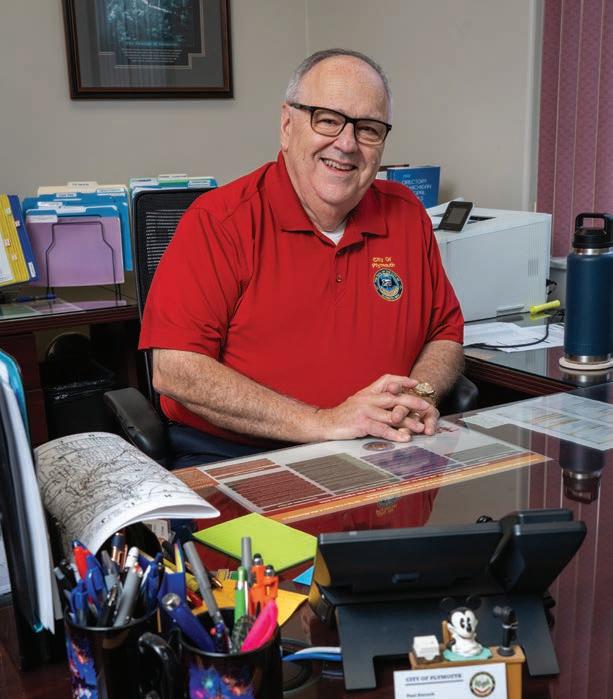
He took his first job with the city as a teenager, watering the trees and flowers in Plymouth Cultural Center parking lot. He earned $1.65 an hour—a nickel more than at his previous job at what was then Taco Bell on Main Street (it is now Hungry Howie’s). In the fall and winter he moved indoors and cleaned the restrooms and locker rooms. When he turned 18, he started driving the Zamboni—a goal of his younger self that ultimately proved disappointing.
“I know Zamboni drivers out there have this great image but, after the first 10 times, it’s just right turns at eight miles an hour—on a good day,” he said with a chuckle.
He worked his way up through various parks and recreation roles, eventually becoming the manager of the cultural center before moving into city hall and taking on additional responsibilities. He was the director of public works at one time, director of public safety, too.
again, for the most part—it’s not going to have that big of an impact. But local government? Is my street going to get paved, do my streets get plowed in the winter? Those basic services that have the biggest impact on you are made by local elected officials. We should have a higher turnout for city commission elections than we do for presidential elections. This is where it happens. This is important.”
“It’s been a great, fun ride,” said Plymouth City Manager Paul Sincock.
It was the day after the August primary and Sincock was sitting in the office he’s occupied for nearly 25 years—an office that he will vacate in October, capping a legendary career of service to his hometown.
Sincock, 68, announced his retirement on July 21. His retirement will be official in the middle of October.
“My brother has a term he calls QTL—Quality Time Left,” he said. “You start thinking you’re closer to one end than the other. This is a 24/7 thing. You don’t realize the stress because it is a 24/7 thing. There’s a ton of stress in worrying about police officers all night long, or when the municipal services crews drive
by the house in the middle of the night for a water main break. You worry about that. I just think it’s time to not be in charge.”
Sincock got a taste of community service earlier than most. His father, Robert, was a city commissioner and mayor during his stints as an elected official in the 1960s and 1970s. Back then, city police officers dropped off commission packets at commissioners’ homes while they were out patrolling the community.
“I think that’s where I really got it from,” he said. “I’d go through [the packet]. He’d always ask what’s on the agenda. We’d talk about city stuff, never thinking we’d end up where we end up.”
Throughout that time he was influenced by the politics of the day, and recalled instances where he would find the late U.S. Rep. Carl Pursell sitting on his porch and talking amicably with former Speaker Tip O’Neil, after he dropped former commissioner and mayor Phil Pursell off after a night at the ice rink.
“In today’s world of politics, that doesn’t happen—at all. I think that was instrumental in understanding politics, or how politics should be,” Sincock said. “You can disagree, but don’t be disagreeable.
“Obviously, a city manager is not an elected position, but you work for elected folks,” he added. “Elected positions are important to the community. I always say this about local elections: what happens in Washington is not necessarily going to have that big of an impact on you, for the most part. What happens in Lansing—
That sense of importance may have been weighing on him in 2001. It was a tumultuous time in the city’s history. The city had gone through three city managers in as many years, tried unsuccessfully to hire others and the commissioners were in a deadlock. They were also grappling with the need to raise water rates by 47 percent— the result of several years of not passing increases along to residents—and had barely enough money to cover payroll. Without a fund reserve, the city only had about $150,000 cash on hand. One of the local newspapers had gone rogue, even offering a $10,000 “bounty” to anyone who could provide dirt on city staff or officials. The commission itself was fractured and argumentative.
“It was a very unstable time. Finally, the community said ‘enough.’ The community was ready for stable local government,” he said. “They didn’t want to see the bickering at the city commission. I think the city commission was ready for that, too.”
During the midst of that time, then-commissioner Colleen Pobur approached him and said: “Paul, we’ve got good news and a little bad news. We found our next city manager.”
“That’s great,” Sincock recalls saying. He was the acting city manager at the time, and eager
“We’re built on service to each other. That’s what I think is really cool about Plymouth…It’s a combination of everyone stepping up to do their part. In my lifetime, I have seen that time and time again: The community saw a need and they came together to meet that need.”
Paul Sincock, who will be retiring as city manager in mid-October
to get back to his full-time role in the DPW. “What could possibly be the bad news?”
“It’s you,” was the reply.
At first, he protested, but Pobur—and the city—ultimately won the day. “You know it’s the right thing for the community,” she told him. And it was.
Change didn’t happen overnight.
“You can’t move an aircraft carrier off the sandbar with one swift move. It took some time,” Sincock said. “We just put some rules in place. We did a lot of things through the course of time.”
A big fan and regular visitor of Disney World in Florida, Sincock brought the resort’s dedication to customer service to Plymouth. They worked on improving service to residents and fostering more positive interactions among staff.
They adopted “the five rules” to guide their decisions: Is it right for the community? Is it right for the city? Is it legal and ethical? Does it sit within the scope of our policies and procedures? And, perhaps most importantly, is this something I’m willing to be accountable for?
They also instituted programs like the Penguin Award, which any employee could give to another if they witnessed them going above and beyond to help out a resident. They worked on breaking down silos between departments and fostering an atmosphere of collaboration throughout city hall.
“People started noticing positive
things. That was our biggest shift,” he said. “We went from a difficult time to having a very positive attitude about everything. It turned our entire perspective. We worked to change our overall attitude and focus on positive things. We still do that today.”
It would be easy to point out the many improvements throughout the community that were realized during Sincock’s long career, from the Sheldon Road underpass to the redevelopment of the former Bathey Manufacturing site along Lilley Road, to the thriving downtown—Sincock wrote the original Downtown Development Authority (DDA) plan—and more, but, when asked, Sincock quickly answered “collaborations.”
Memorial Day Parade, and the Kiwanis and Rotary clubs, which pay for the 4th of July Parade, and the clubs that provide funding for park improvements, too. Prominent landmarks like the Veteran’s Memorial Park and the Gathering were developed through community and service club partnerships, too.
“We’re built on service to each other. That’s what I think is really cool about Plymouth. It’s service-based vs. governmental based,” Sincock said. “These things would not have happened without community involvement. It’s a combination of everyone stepping up to do their part. In my lifetime, I have seen that time and time again: The community

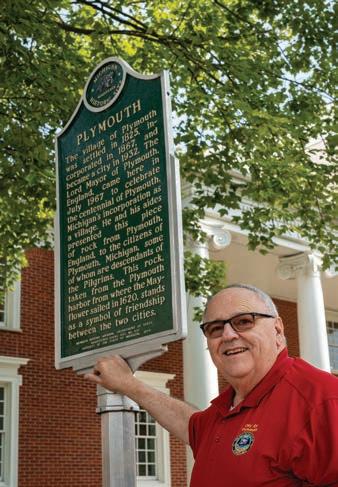
was space for all of us to leave ours,” said City Commissioner Nick Moroz. “The parks, the programs, the decisions that shape daily life in Plymouth, they reflect not just one person’s vision, but a shared sense of purpose. I think that’s the ultimate legacy for any public servant.”
‘I CAN’T JUST STOP’ Sincock will remain on the job until the middle of October, finishing off what will be a 48-year career. Assistant City Manager Chris Porman will take the reigns after that. The commission voted unanimously to appoint him, but the details of the contract have yet to be worked out.
Sincock says he has plans to visit his timeshare at Disney next month, and then take a trip to Italy in November to celebrate the 30th anniversary of marriage to his wife, Traci.
After that? Don’t expect him to just disappear.
He talked about the longstanding partnership with Huron Valley Ambulance, which has not only saved lives, but hundreds of thousands of dollars for Plymouth taxpayers, and partnerships with service clubs like the Lion’s Club, which took over funding for the
saw a need and they came together to meet that need.”
That attitude has inspired leaders past, present and, most likely, into the future.
“The most impressive thing Paul has done isn’t leaving behind his mark, it was making sure there
“Look I can’t just stop. I’ve been working since I was a paperboy way back in the day. I’m not going anywhere. There’s so many positives about this town, our community, our people. It’s a great place. I’m still going to be here,” he said.
“I’ll be working with special event people, I’ll just do it in a different capacity. I can’t just retire.”
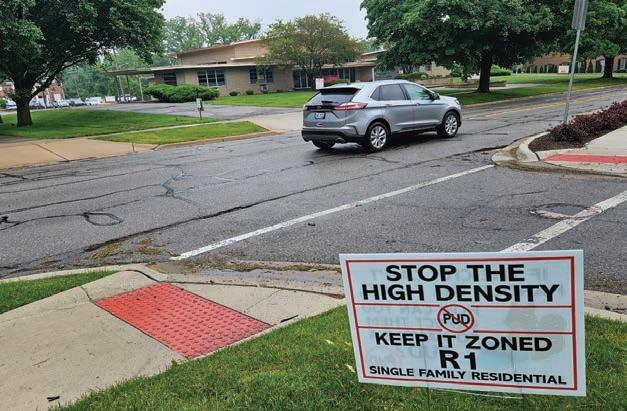
a requirement for the rezoning weren’t true community benefits, since most of them would be required for any redevelopment at the site.
Stop the PUD’ signs are still scattered around the city of Plymouth, but the most important sign of all is no longer there.
The sign in front of the First Church of Christ, Scientist on Ann Arbor Trail that announced a proposed rezoning for the parcel has been taken down and the project itself has been scuttled.
“Ultimately, the church and the developers decided they could not meet the requirements from city planners,” said City Manager Paul Sincock.
Located just west of Harvey Street, the 2.2-acre site has been ripe for development for years as the church congregation has grown smaller and had a more difficult time maintaining the property. The most recent project, called Brookside, was brought forth by Champion Development and has been in the planning process for more than two years. Champion proposed a Planned Unit Development (PUD) that would have featured a new, 3,400-square-foot church, along with 20 homes.
Under the plan the two existing buildings on the site would be

Representatives from Champion Development have not responded to requests for comment, but Doug Hamborsky, director of Design & Construction for Champion Development, said those benefits would have included additional tax revenue for the city, an underground detention basin that may have helped alleviate flooding due to stormwater runoff, and fixing up the path along Tonquish Creek, which is on the north side of the property.
The PUD was granted preliminary approval from the planning commission earlier this year, but developers ultimately decided it was not feasible to meet the requirements necessary
attempt by the developer to work with the individual neighbors around it. They worked with the church and the city and that was it—and that was not acceptable. We’ve got a voice and we’re going to have a say on it.”
The Champion development will most likely not be the last attempt to redevelop the property. Already talk is circulating about new proposals for the property that would include a smaller version of the church along with some single-family homes.
John Buzuvis, Plymouth Economic Development director, said nothing official has been submitted.

Lorenz and his group said they’ll keep their signs up, for now, but they are not opposed to any kind of development there.
“If it’s acceptable to the community, we’ll get behind it,” Lorenz said.

razed; the current 8,000-square foot church would be replaced with a 3,400-square foot structure on the western side of the property and two additional buildings with a combined 17 condominiums would be constructed between the Ann Arbor Trail condominiums and Tonquish Creek. Three 2,600-suqare foot detached condominiums would face Ann Arbor Trail.
It was first proposed in late 2022 and residents who live nearby opposed it ever since, calling it too dense and too out of character for the neighborhood. They cited traffic and pedestrian safety concerns, too, because the site borders Tonquish Manor, a senior living facility. They were also concerned that the “community benefits” touted as
to bring it back for final approval, a step that would then have sent it to the city commission to either accept or reject it.
“Obviously, this is good for residents,” said Ron Picard, a city commission candidate who has been opposed to the development from the beginning.
Scott Lorenz, a city resident who has helped organize opposition to the project, said he was completely and utterly satisfied that its current incarnation was not moving forward.
“It’s a travesty that it went on as long as it did,” Lorenz said. “This could be a study at Harvard about how not to do a development, because every aspect of it was pathetic. There was no community relations whatsoever. There was no
Picard agreed.
“With some of these other potential developments, hopefully it’ll be something that everybody is happy with,” he said. “I think they will be able to do something that’s a lot less dense than what this would’ve been.”
A controversial plan to build condos on the 2.2 acre First Church of Christ, Scientist site on Ann Arbor Trail near downtown Plymouth has been scrapped. The property is expected to draw interest from other developers. What would you like to see happen to the property? Email your opinions to Editor Scott Spielman at scottyspielman@ gmail.com.










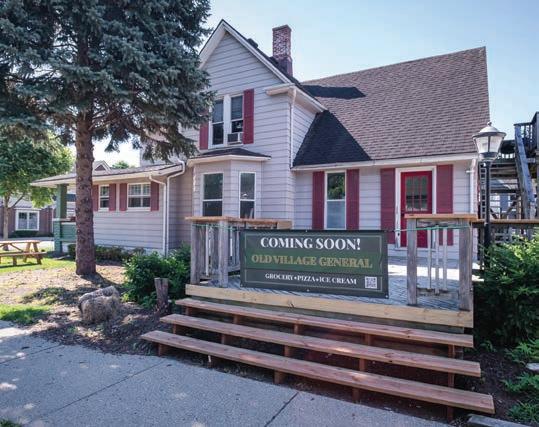
By Scott Spielman | Photos by Bryan Mitchell
Anew business in Plymouth’s Old Village will add to the eclectic atmosphere of the city’s “other downtown.”
The Old Village General Store, on the corner of Liberty and Mill streets, opened last month, providing a unique combination of small grocery staples and graband-go meals and merchandise.
Located in a historic building that dates back prior to 1900, the store is the brainchild—and lifelong dream—of Plymouth builder Anthony Giglio, who lives a few blocks away, north of Wilcox Lake.
“I’ve always had that itch to have my own place,” said Giglio. “I’ve just been waiting for the right opportunity and location and this one, fortunately, came to me and I’ve been really happy with the way it’s shaping up. Everybody is really excited about it. It’s keeping that nice, historic look: up north, approachable, like back in the day.”


Giglio said he designed the business to fit a need he saw in the neighborhood: a small shop where shoppers can grab a few essentials, some unique items and a quick meal without breaking the bank.
“Living in this area, I constantly feel like there isn’t a good local store to go grab a couple of things—I’ve always got to go to Kroger, or Westborn—or a sandwich and pizza shop that isn’t going to cost me $25 for lunch. I want to bring that back.”
His family is no stranger to the business. His father operated a small grocery store in Pontiac and his great-grandfather ran one during the Great Depression. The Old Village General Store features a small assortment of household staples, local merchandise like jewelry, Old Village t-shirts, cutting boards or cheeseboards, along with selfserve coffee machines, soft-serve ice cream and a deli counter.
A pizza oven churns out 13"
pies. The deli counter will feature monthly specials—all reasonably priced. There will be plenty of places to sit, too, both inside and on the deck facing Liberty Street, which also features a walk-up window where shoppers can order food.
Giglio, who renovated the Red Ryder around the corner prior to its reopening, did all the restoration work himself with a single helper. Keeping the character of the building was important to him—he said he wants to look into getting a historical designation for the old home to help preserve its architecture in the future.
“This neighborhood is that type of neighborhood,” he said. “We like our village old. We like it traditional, so I think the fact that we can keep this in this state and refurbish it is a great thing.”
The Old Village General Store is open for breakfast, with breakfast pizza, bagels and other options, and stay open for the
late night crowds on Fridays and Saturdays—and, of course, during the day when families can stop in and grab provisions during their outings.
“The whole concept is that I want affordable, quality food where it’s not a million ingredients, just a couple good quality ingredients,” said Giglio, who also sells . “If you’re taking your family to Hines Park or if you’re going to Kensington or out on the lake, you can grab some sandwiches, chips and you’re out the door. I want it to be affordable, quality, just fast grab and go.”
Eventually, he said he’d like to look at expanding the operation. There’s room for a food truck and beer garden in the back, and Giglio has an old 50s camper that he could renovate for that. He said he’d also look into getting a liquor resale license so he can add whiskeys and wines to the shop’s offerings. Ultimately, he said, the neighborhood would define what people can find there.
“If you’re taking your family to Hines Park or if you’re going to Kensington or out on the lake, you can grab some sandwiches, chips and you’re out the door. I want it to be affordable, quality, just fast grab and go.”
Anthony Giglio, owner of Old Village General Store
“We’re just going to see how the neighborhood takes it, what they want to see in here,” he said. “I just want people to walk out and say ‘that was a good item and I paid a good price for it.’
The store officially opened during the July Bumpers, Bikes and Bands event. Giglio said that was important, and he’s looking forward to all the upcoming improvements and activities scheduled for the Old Village area. The City of Plymouth is on the cusp of creating a Tax
Increment Financing Association (TIFA), which will capture increases in tax revenue to fund infrastructure work to enhance the charm of the neighborhood.
“We’ve got big dreams. This whole corridor here is going to be really big in the next couple of years,” he said. “It’s my baby. I think it’s a little bit of everything I’ve been doing my entire professional life. It’s coming together. I hope this place is a staple in the neighborhood for a good 30, 40 years, a good corner

store for the people. That’s the core of it all.”
City Commissioner Nick Moroz, who has long been supportive of the business community in Old Village and helped spearhead the TIFA concept, said he likes what he sees going on there, with the unique shops and eateries.
“They’ve maintained this culture that is slightly quirky, slightly artistic, and I think it really fits the ethos of Old Village in a way that compliments the
OWNER: Anthony Giglio
ADDRESS: 689 N. Mill Street, Plymouth, MI
PHONE: (734) 259-8101
HOURS: 11 a.m.-9 p.m. Mon-Thurs; 11 a.m.-10 p.m. Fri; Noon-10 p.m. Sat; Noon-8 p.m. Sun

(Southfield, MI) The late Dr. Warren Ringold knew firsthand the devastating impact of late-stage cancer diagnoses. As a respected family physician, he witnessed countless patients battling illnesses that could have been detected earlier. His own grueling battle with late-stage cancer ignited a passion, leading him to create Michigan’s first MRI full body screening center called Bionicc Body Screening.

SOFTBALL SIZE TUMORS SILENTLY GREW
Softball Size Tumors Silently Grew
Dr. Ringold discovered he had stage four cancer with tumors as large as softballs silently growing inside his body after experiencing shortness of breath. His treatment was brutal. He su ered cruel side e ects. After his cancer went into remission, it returned a year later as a brain tumor. Dr. Ringold believed there had to be a better way. He envisioned a future where individuals could take control of their
Dr. Ringold discovered he had stage four cancer with tumors as large as softballs silently growing inside his body after experiencing shortness of breath. His treatment was brutal. He suffered cruel side effects. After his cancer went into remission, it returned a year later as a brain tumor. Dr. Ringold believed there had to be a better way. He envisioned a future where individuals could take control
of their health and detect potential problems before they escalated. In his final days, Dr. Ringold passionately advocated for MRI full body screenings, a proactive approach he believed could empower individuals to take control of their health.
FULL BODY MRI SCANS WITHOUT A DOCTOR’S ORDER
(South eld, MI) e late Dr. Warren Ringold knew rsthand the devastating impact of late-stage cancer diagnoses. As a respected family physician, he witnessed countless patients battling illnesses that could have been detected earlier. His own grueling battle with late-stage cancer ignited a passion, leading him to create Michigan’s rst MRI full body screening center called Bionicc Body Screening.
health and detect potential problems before they escalated. In his nal days, Dr. Ringold passionately advocated for MRI full body screenings, a proactive approach he believed could empower individuals to take control of their health.
Raising Awareness
Full Body MRI Scans Without a Doctor’s Order
RAISING AWARENESS
Today, his son Ryan carries on this mission. ough not a medical professional himself, Ryan’s dedication to his father’s legacy drives him to raising awareness of this service for families of Michigan.
Today, his son Ryan carries on this mission. Though not a medical professional himself, Ryan’s dedication to his father’s legacy drives him to raising awareness of this service for families of Michigan.
“Every week I learn of another person who felt perfectly ne, only to wake up with an unexplained symptom and discover they have stage four cancer. Once symptoms manifest cancer is usually advanced,” says his son Ryan. “My father never wanted another family to su er the emotional and physical hardships that our family and he endured. He wanted to save lives.”
Bionicc Body Screening o ers elective, full-body MRI screenings that provide a comprehensive picture of your internal health, going beyond what traditional checkups often reveal. State-of-the-art technology can detect tumors as small as a pea, aneurysms, risk of stroke and a multitude of other conditions that might otherwise go unnoticed. Screenings include scans of the head, neck, chest, abdomen, pelvis, hips, shoulders and spine.
A Life Saved
“Every week I learn of another person who felt perfectly fine, only to wake up with an unexplained symptom and discover they have stage four cancer. Once symptoms manifest cancer is usually advanced,” says his son Ryan. “My father never wanted another family to suffer the emotional and physical hardships that our family and he endured. He wanted to save lives.”
Scans are safe, non-invasive, emit no radiation and are available without a doctor’s referral.
Bionicc Body Screening offers elective, full-body MRI screenings that provide a comprehensive picture of your internal health, going beyond what traditional checkups often reveal. State-of-the-art technology can detect tumors as small as a pea, aneurysms, risk of stroke and a multitude of other conditions that might otherwise go unnoticed. Screenings include scans of the head, neck, chest, abdomen, pelvis, hips, shoulders and spine.
Mark B. and his younger brother decided to visit Bionicc Body Screening last spring for a proactive screening because cancer ran in their family. Mark was skeptical until his results returned a 3-centimeter mass on his lung, which tested positive for cancer. He had three-fourths of his lung removed. He credits the scan for saving his life. Meanwhile, his brother’s results were clean.
A LIFE SAVED
LIMITED TIME OFFER - Learn more now. Visit BioniccBodyScreening.com to download a free Welcome Information Kit and $200 savings offer. Book an appointment by calling 1-833-BIONICC. (833-246-6422)
Mark B. and his younger brother decided to visit Bionicc Body Screening last spring for a proactive screening because cancer ran in their family. Mark was skeptical until his results returned a 3-centimeter mass on his lung, which tested positive for cancer. He had threefourths of his lung removed. He credits the scan for saving his life. Meanwhile, his brother’s results were clean.
Located in South eld

are safe, non-invasive, emit no radiation and are available without a doctor’s referral.



Plymouth’s Old Village is crackling with new life and changes are under way that will help sustain it for the foreseeable future.
For the first time in the history of the city’s ‘other downtown,’ city officials are dotting the proverbial ‘I’s’ and crossing the ‘t’s’ to set up a dedicated funding stream to pay for ongoing improvements in the area between the traditional downtown and Hines Park.
The city is establishing a Tax Increment Financing Authority (TIFA) district and Corridor Improvement Authority (CIA) for a large portion of the area many call Lower Town in order to tackle infrastructure improvements and other upgrades.
“The whole idea to create a district is to fund projects that otherwise wouldn’t happen,” said John Buzuvis, Economic Development Director for the City of Plymouth. “A lot of those are infrastructure-based and none of those are getting any cheaper as time goes on.”
TIFA districts function

like traditional Downtown Development Authority (DDA) districts. Once the district is created, a board is appointed to develop a plan for projects and a base year for the tax capture is established. In this case, 2025 would be the base year. Any increase in tax revenue after that—either through regular property value increases, sale of property or property improvements—are then tapped to fund improvements within the district. Tax rates do not increase, the funding is merely redirected and dedicated to the district.
The city has only recently embarked on what is a long, complicated process. The city commission hosted a public hearing on the idea in June. State statute requires a 60-day waiting period prior to the next step, which is the formal resolution to create the district. That was scheduled to take place at the Aug. 18 Plymouth City Commission meeting, when The Rock was already at press.
After that, state statutes dictate
another 60-day period in which a board is appointed and a plan developed, then another public hearing on those details. Buzuvis said he anticipates that happening in late 2025. After another public hearing in the first quarter of 2026, everything should be in place to begin the revenue capture on next summer’s tax rolls.
He said the initial thought is to develop a 25-year plan for the district.
“It’s going to take a few years to get some funding built up and then, if we want to or need to bond anything out, it’ll give us time to be able to build up a healthy revenue stream and pay off that bond,” he said.
The proposed boundaries are, generally, from Main Street/ Plymouth Road to Wilcox Road and from Holbrook to Starkweather and some properties west of Starkweather. There are about 250 properties included within it. The size of the district and its makeup—it must contain at least 50 percent of first-floor retail, commercial or industrial—
and dictated by the state.
The size of the district was one of the concerns voiced by Old Village residents at the June public hearing. Traffic was another, along with the makeup of the board and communication with residents and property owners. Members of the Old Village Association (OVA) Board, an official city board made up of volunteers, wanted to make sure they would be involved in the process.

Mark Oppat, an OVA member who has long been active in the area, cited a past lighting project that clashed with the unique ambiance of the village.
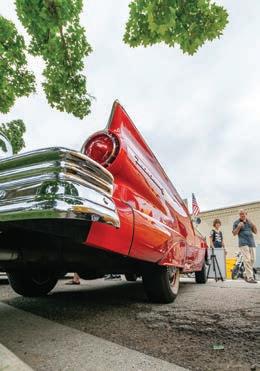
“We lost the atmosphere of the village at night when that happened,” he told the commission. “It wasn’t a cost
factor; we just weren’t consulted.”
City Manager Paul Sincock, who wrote the original plan for the Plymouth DDA, assured residents that the TIFA board would be made up of residents and property owners within the district.
Although the district has not yet been officially created nor a plan developed, some projects are already in the early discussion phases, notably an improved pedestrian walkway from the village to Hines Park along Wilcox Road. The county is looking for ways to improve access to Hines from the dozen communities adjacent to the park, which is among the longest linear parkways in the country.
“It has been a goal of the city commission, and the county, for years to create a more pedestrian friendly connection to Hines Park,” Buzuvis said. “We have had some preliminary meetings with the county. The Wilcox
Mill is being redeveloped, and we’ve had some discussions with that property owner about what [the connection] might look like and how it might go. We want to create an easier and safer way to get into Old Village. That’s going to be good for the community and the city for the long run.”
The city commission, for it’s part, is eager to keep the momentum going.
“This is a very positive step in the right direction,” said Mayor Pro Tem Colleen Pobur.
“It’s been a long time and it’s something I’m very excited about,” added Commissioner Nick Moroz.
Buzuvis agreed, saying the ultimate goal is to build on the healthy growth the Old Village area is experiencing, while maintain and respecting its unique character.
“The city of Plymouth is very fortunate to have two separate

downtown areas,” he said. “There are not many municipalities as small as we are that have that— and they both offer something a little bit different. I’m excited for the Corridor Improvement Authority because we can really capture and take advantage of the synergy we can have between the two districts in town. Old Village is just awesome.”







For more than six decades, Plymouth has always come out strong in the name of supporting all the good work many groups and citizens do year after year.
It’s literally a case of “winner, winner, chicken dinner” when it comes to the annual Plymouth Fall Festival, slated for Sept. 5-7 this year.
As many as 10,000 barbeque chicken dinners are being prepped by the Rotary Club of Plymouth - Noon to sell to hungry festival goers. That aroma will be impossible to
escape during the annual festival, because Rotarians will be grilling chicken on makeshift fire pits in the parking lot behind the Penn Theater.
Rotary Club chicken dinners will be featured on Sunday, Sept. 7, with pre-sales continuing ($17) at Friday night concerts at Kellogg Park during August (including psychedelic rock mainstays Magic Bus on Aug. 29), said Plymouth Downtown Development Authority director Sam Plymale. (The dinners are $20 if bought on the day and there will be a drive-through
Club, the one which meets in the morning, also will be busy working to feed some of the expected 75,000-to80,000 patrons who descend on downtown Plymouth for some or part of the festivities. The Rotary Club of Plymouth - A.M. is making and selling spaghetti dinners, which will be enjoyed on Saturday night, Sept. 6, at the Party Tent behind EG Nicks.
“The spaghetti dinner is only one night and the chicken dinner is only Sunday,” Gietzen said. “So you could really eat your way through the weekend down there.”
But the two Rotary groups won’t have a monopoly on festival goers' anticipated munching.
The Kiwanis Club’s pancake breakfast is Saturday morning, the Vietnam Veterans of America Chapter 528 is hosting a Friday night rib dinner (also at the EG Nicks’ Party Tent) and Gietzen said not to forget about typical carnival food fare “along with Polish food and all the other food options there are at the event.”
Several businesses will partner with food trucks, with a portion of proceeds donated to nonprofits and service groups.
location beginning 11 a.m. Sept. 7 at West Middle School.)
“There is a chicken preparation area, a corn prep area, another area where they boil the corn,” noted JAG Entertainment’s James Gietzen, a festival organizer and Plymouth Rotarian. “And the pitmasters’ area, all of that (food) is brought up front where they go through the packaging. That’s where they combine a half-chicken, an ear of corn, a cookie and a bag of chips into a box and send that up to the front for people to buy.”
Plymouth’s second Rotary
Of course, there will be tons more on the menu – food or otherwise – during the three-day extravaganza, which the DDA’s Plymale said is a very important way for people to support the many non-profit organizations and civic groups that do so many unheralded things for the Plymouth community.
“It’s really the one event that benefits all the service clubs in town, the non-profits,” Plymale explained. “Really, that’s what the event is all about. It’s helping out all those clubs that provide a huge service in our community and help out the needy and do a lot of good things in the community.”

Plymale said the fest and its carnival-esque presence not only engulfs Kellogg Park, it will be omnipresent along Main Street, Ann Arbor Trail and adjacent streets.
Fall Fest, he continued, is not always the “most businessfriendly event,” but downtown businesses should garner some benefit that could bring them future customers.
“For an event like this there’s always some grumbling, because
a gift for their mom or dad with a birthday coming up in the next couple months.”
Whether or not future sales do arise from festival goers, the overriding sentiment is businesses “understand” up front they are helping groups that give so much to Plymouth.
Meanwhile, many civic groups will help present various entertainment activities and
Centennial Dancers, pompon teams from all three high schools (Plymouth, Canton and Salem), Steve Taylor 3 and the Dearborn Big Band. Also, Midwest Taekwondo is set to perform demonstrations.
Gietzen added that classic rock groups will dominate the primetime festival stage, with 7 p.m. concerts Friday and Saturday, respectively, by Jeff Phillips and Friends and the Phoenix Theory Band.
This year’s many food and entertainment options merely continue the Plymouth Fall Festival’s long-standing tradition of helping people have a great time all while boosting money and awareness for clubs and groups.
“My whole thing with the Plymouth Fall Festival is it’s the original community fall festival and it was built to do fundraisers for non-profit organizations in the community,” Gietzen stressed. “So all the food at the festival, all the different fundraising activities go to a local service organization that serves the Plymouth area.
“All the fun is secondary to
“My whole thing with the Plymouth Fall Festival is it’s the original community fall festival and it was built to do fundraisers for non-profit organizations in the community. So all the food at the festival, all the different fundraising activities go to a local service organization that serves the Plymouth area."
James Gietzen, festival organizer
they may not be getting more people through their doors,” Plymale said. “But I always tell business owners, when you have tens of thousands of people walking by your store for an event like this, maybe they’re not coming into the store this time but there’s an opportunity to market directly to those people.
“Maybe it’s somebody that didn’t know your store existed and they may come back to buy
spectacles largely on stage in front of the Penn.
For example, Gietzen said the Plymouth-Canton Optimist Club will host its annual pet show (set for Saturday morning); at noon Saturday the Plymouth District Library will present MellyPop! and her fun and interactive puppet show.
There will be performances by the Plymouth Fife and Drum Corps, Polish National Alliance
that. Obviously, you got to have the fun or else people wouldn’t come.”
The recipe has been a triedand-true one since the debut festival in 1960, which followed the first few Rotary Club chicken dinners in the late 1950s.
Gietzen said about 500 people attended the first two Rotary Club chicken dinner events in
FRIDAY, SEPT. 5
7 p.m. Geff Philips & Friends
SATURDAY, SEPT. 6
9 a.m. Optimist Pet Show
Noon The Plymouth Library presents an interactive puppet performance by MellyPop
2 p.m. Dance Beat/Forever Af ter Productions
3 p.m. Plymouth Fife and Drum Corp
4:30 p.m. Polish National Alliance Centennial Dancers
7 p.m. The Phoenix Theory Band
SUNDAY, SEPT. 7
10 a.m. Midwest Tae-Kwon Do 11 a.m. Chiefettes, Saberttesm, Rocket’s Pompon squads
12:30 p.m. Dearborn Big Band
3 p.m. Steve Taylor 3
*All shows in Kellogg Park
Continued on page 16

Rock
Continued from page 15
1956 and 1957, with proceeds used to help build playground equipment.
A third Rotary picnic, in 1958, enabled football field lights to be installed at what was then Plymouth High School – and which today is Plymouth Arts and Recreation Complex.
Plymale emphasized that downtown

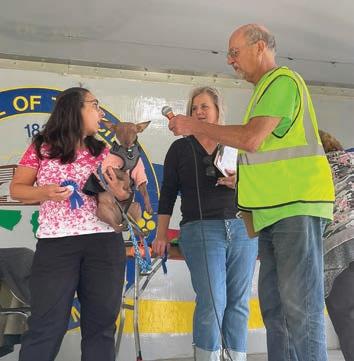
parking lots, such as the central parking deck, will be operated by volunteers from the Plymouth Lions Club. Motorists will be charged $10 to park, with those proceeds in turn used to help the organization fund its programming.
“We have to have our public parking lots managed,” Plymale said. “If we didn’t do that it would be chaos, people wouldn’t be able to get in and out of the lots. So what we do is we hire these non-profit organizations.”
The Lions, Rotary and Kiwanis clubs usually rotate parking lot-management duties for major DDA events, including the Fall

Festival, Art in the Park and Ice Fest.
“I just urge people to come down here and support, donate to your favorite organization and support the organizations that make our community what it is,” Plymale added.
There also will be an ongoing shuttle between Praise Community Church (45000 N. Territorial Road) and downtown Plymouth, to accommodate others. The service will be available as follows: Friday, 3:30 p.m. to 9:30 p.m.; Saturday, 10:30 a.m. to 10:30 p.m.; Sunday, 10:30 a.m. to 5:30 p.m.

To find out more about the festival, go to plymouthfallfestival.com and click on the events tab.





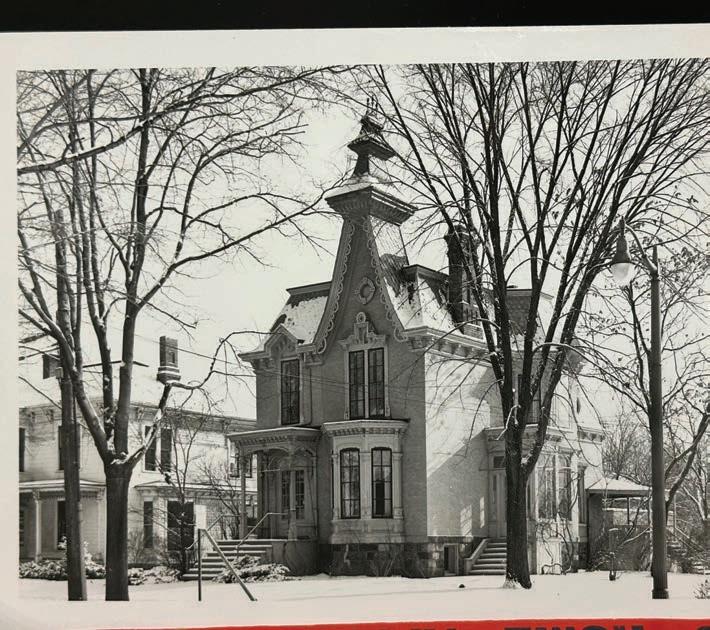
VITRINE invites you to join us in honoring 150 years of The Baker House with a month full of surprises, style, and celebration!
• Baker Bucks Giveaways Shop and earn store Baker Bucks Gift Cards.
• History Display in Our Gallery Explore The Baker House’s story and enjoy weekly Baker House–themed gifts with purchase.
• Mr. Baker Selfie Contest Snap a selfie with our beloved Mr. Baker & win prizes!
• Pink Tea Event In honor of the home’s “pink house” history.
• Pink Hanger Event Look for the pink hangers for special anniversary savings!
• Tent Party in the Parking Lot Live atmosphere, special deals, and community fun.
• Anniversary Cake Cutting Celebrate with us and enjoy a slice of history!
• Extra Giveaways Surprises all month long.
By Brad Emons

If there’s three teams that would like to prove the football prognosticators wrong in the KLAA’s West Division, it’s the three schools at Plymouth Canton Educational Park -- Plymouth, Salem and Canton.
During the KLAA’s football
media day on Aug. 7 at Genitti’s Hole-in-the-Wall in downtown Northville, the preseason coaches poll predicted Howell would repeat as West champion, followed by Brighton, Northville, Novi, Hartland, Plymouth, Salem and Canton.
Here’s a closer look at the three
Park football programs entering the 2025 season.
The Wildcats (3-6, 2-5 in 2024) have three returnees on offense and five on defense as third-year coach Greg Souldourian will have to replace several key contributors on offense, but Plymouth does return three of four defensive backs in the secondary.
“I think at the end of the day I like that people doubt us,” Soudourian said. “I’m one of those people that if you tell me I can’t, I’ll show you I can. And I think our kids have taken on that persona. We’ve got some young kids that are looking to step up, and we’ve seen it throughout the summer. Believe it or not, this group is actually stronger than our group from last year as far as the weight room numbers, so it’s pretty exciting.”
Among the key returnees include Max Hornbacher, senior tight end-linebacker; Saamir Sain, senior wide receiverdefensive back; Kaiden Moore, junior running back-defensive back; Joel Dewberry, junior wide receiver-defensive back; Ethan Sober, senior wide receiver-defensive back; Hayden Schultz, offensive, junior offensive-defensive lineman; Brady Lorenzetti, senior centerdefensive line; and senior Drew Jansen, senior quarterback.
The 6-foot-2, 160-pound Jansen played wide receiver a
year ago and is planning to take over the signal calling duties, where he hopes to provide a strong pocket presence while adding versatility as both a running and passing threat.
His summer offseason, however, was temporarily set back by a spleen injury suffered in travel baseball the first week in June. He was cleared by his doctors to return to full status before the first day of official practice on Aug. 11.
“I haven’t been able to play as much as I wanted to,” Jansen said, “and from what I’ve seen when I came back, I think the team is looking good, looking stronger and it’s a closer bunch of guys. And I think we’re going to be a good competitor in the KLAA this year.”
Jansen feels confident he can be the heir apparent from previous Plymouth starting QBs

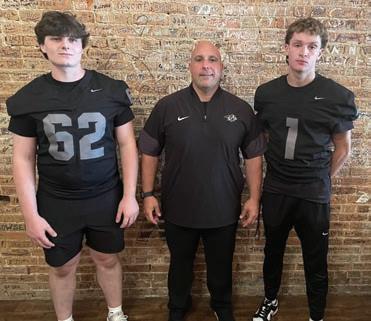
Logan Pheiffer (2024) and Sam Plencer (2023).
“It’s been good,” Jansen said. “I’ve grown a lot seeing Logan and Sam, good buddies of mine, I still hang out with them…I’ve grown pretty good as a quarterback behind those guys.”
And with the summer time off, Jansen believes there has been a silver lining to it all.
“Actually, I think it helped me grow,” he said. “I got a lot of mental reps, watched more film and I think me studying the playbook took time. There was a lot of thinking and I think I grew as a player.”
Meanwhile, the 6-1, 240-pound Brady Lorenzetti will be a catalyst on the offensive line as the Wildcats plan to “pound the rock,” according to the Plymouth coach.
“We’re looking for him to anchor our offensive line,” Souldourian said. “That’s our smartest guy on the offensive line, the leader there the last couple of years and we’re looking for him to be our guy and be a leader on the field.”
For the Wildcats to prove the doubters wrong, it’s going to take a laser-like focus and commitment.

“I think at the end of the day it’s the buy-in of the kids,” Souldourian said. “Belief is above all. We were down to the wire in two games where we lost by a point last year. We’ve shown we can compete with the best. Last year we were at Howell and four-outed inside their own 20. We had a chance to go up 14-0 and we couldn’t score from six inches out. We’ve shown we can compete with the best in our league and our side of the conference, but we just have to believe it and get it done at the end of the day, not do things that will bite us in the butt like as far as turnovers and penalties with that that’s hurt us in the past.”
Things are looking up for the Rocks (2-7, 1-6) who return seven starters on offense and seven on defense for third-year coach Landon Garrett, who is encouraged by the turnout of 138 players combined in the program between the varsity, JV and freshman levels.
Garrett is confident because they’ve been in the system now for a couple of years and know the ropes as they face tough road tests against the KLAA West contenders Howell (Sept. 5) and Northville (Sept. 19).
“It’s a culture and maturity, as far as getting in-time game reps,” Garrett said. “There’s a big difference between being a junior and being a senior. We were in a lot of close games last year, lost four games by a touchdown or less in the last few minutes of each game. The culture that they’ve been bringing and working on turns into maturity, time on the field, those type of things.”
Salem features seven threeyear varsity players.
Luke Creighton, a 6-1, 183-pound senior, returns as

the starting quarterback. He is the son of Eastern Michigan University head coach Chris Creighton.
Garrett says Luke Creighton has proven his leadership skills.
“He came to us last year at the end of the season,” Garrett said. “He did a lot of good things the last couple of games. We’ve talked about that and being able to read defenses. You can’t go broke taking a profit. We talk about that all the time, and the culture and the understanding that he’s the leader out there, but there’s 10 other guys that have to move in the system with him.”
Creighton has also bulked up from a year ago.
“He’s gained about 20 pounds in the offseason of just muscle,” Garrett said. “He finished last
year probably at 162 and this year he’s up to 183 right now. He’s been working his butt off in the weight room and in the classroom as far as football goes, just really becoming a student of the game.”
Creighton witnessed last season that there was a razor-thin line between winning and losing.
“Last year was tough. Five games were by one score that could have gone either way,” Creighton said. “But this year we’re real close with the seniors that are coming back. That will be fun.”
Replacing running back Aiden Moore, who is now at Northwood University, will be the biggest hole to fill.
Continued on page 20
“It will be different, mostly the same scheme but a little different without him, so we’ll see,” Creighton said.
Other key returners include Landon Garrett, senior wide receiver-middle linebacker (his 114 tackles led the team); Nye Turner, senior wide receiver-defensive end; Drew Eisenbeis, senior tight end (committed Saginaw Valley State); Kyle Candito, backup junior quarterback-linebacker; Caleb Chinyadza, junior wide receiver-defensive back (started as a sophomore); Ethan Cooper, senior center; Adam Uranga, senior guard; Kai Prinzevski, senior kicker-defensive back; and Curtis Crittenden, senior running back-nose guard.
“I think it’s going to be great,” Creighton said. “We’re ‘Burning the Boats,’ that’s our motto this year. No more the old Salem, we’re going places this year. It will be fun.”
According to legend, Spanish conquistador Hernán Cortés issued a rather interesting order to his men as they began their conquest of the Aztec empire in 1519.
The order was simple: Burn the boats.
“Burn the Boats means you’re done with the old,” Creighton said.
And for Salem and Garrett, it’s all about building a program and changing the culture.
“The one thing I can say about this senior class – there’s one word to describe them – it’s coachable,” said the Rocks’ coach, “and hungry would be the other one.”
Canton (2-7, 0-7), under second-year coach Eric Newton, features four returners on offense and four on defense.

The team’s youth and inexperience will be a big challenge for the Cobras, but the team’s philosophy since the 2024 season ended has been: “Clock in.”
“Mistake-free football and competing for all four quarters is what it’s going to take,” Newton said. “We’ve got a good group of kids coming in. They’ve jelled over the summer and just making sure that we come together. We’ve battled through adversity the last two years, so that really shouldn’t be an issue of keeping guys engaged in those tough games week-to-week on our side of the conference.”
And Newton believes they’re headed in the right direction in all phases of the program.
“Just based off the winter when we tested, 90 to 95 percent increased their squat . . . so you can see they put in the work, because again, when you’re lifting weights you can’t lie,” the Canton coach said. “If you’re not showing up then you’re not putting the work in.”
Canton will implement a similar style of offense from a year ago.
The Cobras have been primarily a T-formation team, but Newton plans to spread it out with 11 personnel while trying to get his athletes in the best position possible where they can be successful.
Patten, junior running back-slot receiver-cornerback-safety; Nick Dimitroff, senior running backdefensive back; Zion Malone, sophomore offensive-defensive lineman; and Jamari Storie, senior defensive back.
“We have a great group of guys coming in and we have a great coach in Coach Newton,” Wetmore said. “And he’s put a plan in for us and we’re just following suit with that plan. We’re just working hard this summer to meet expectations whatever the opponent because we want to meet that expectation.”
And according to Patten, the team has forged a closer bond on-and-off the field.
“Our discipline has gone up a lot,” Patten said. “We’ve come together a whole lot. We don’t have split groups. We’re all talking as a group and just having a good time out there. We have more chemistry overall.”
Despite being picked last in the KLAA West, Canton hopes to prove the skeptics wrong.
“We just got to get better at finishing,” Newton said. “Last
year we were in games, then in the second half a mistake or penalty would happen. So, if we can stay mentally sharp and finish, I think we should be very, very competitive.” Continued from page 19
One encouraging sign this season is that Canton will have all three levels of teams – freshman, JV and varsity. The strength is in the numbers as the program has risen to 105 players overall.
Among the key returnees are Colin Wetmore, senior center-defensive line; Elliott





Full Digital Edition with expanded news coverage available September 1 on website: plymouthmi.gov

The Plymouth Cultural Center Ice Arena is getting new energy-efficient lights. The installation of Light-Emitting Diodes (LED) lighting system supports the City Commission’s goal of sustainable infrastructure and being eco-friendly. The lights were purchased with a recreation grant from Wayne County. Don Green of Green Electrical Solutions is implementing the installation.
The Plymouth Cultural Center Ice Arena is the only arena in the state of Michigan which operates with an environmentally friendly Geo-Thermal ice plant. It’s a system where heat from the ice is pulled out and then used to heat the building and generate hot water supplies throughout the facility.
Scott Silvers was eliminated from the Plymouth City Commission race by only nine votes, losing out to the 8th-place finisher, Jim Mulhern, 444-435 votes. City of Plymouth voters made their selections during the August 5 Primary Election. At stake was the elimination of one candidate to narrow the field from 9 to 8 candidates for the Tuesday, November 4 general election.
Now, City of Plymouth voters will elect four (4) candidates from the 8-person field to the Plymouth City Commission in November. Voters will elect three Commissioners to 4-year terms, while the fourth-place finisher earns a 2-year term
Utility work continues on Holbrook between Plymouth Road and the railroad tracks The City’s contractor team has installed all the new 8-inch water main, new valves and new hydrants. Before connecting the residents to the new water main, the contractor will be completing the required testing of the new water main.
Residents on York Street and Liberty east of Holbrook will need to use the alternate access through the gravel business drive from the north end of York Street. Residents with questions can call Shawn Keough (project engineer) at Wade Trim at 313.363.1434 or the City Municipal Services Office at 734.453.7737.

The beloved Plymouth Fall Festival returns to downtown Plymouth from Friday-Sunday, September 5-7. This year’s event promises to be an exciting weekend packed with family-friendly activities, entertainment, and community spirit. This world-class festival is a celebration of the season. It serves as a crucial fundraiser for local non-profit organizations, allowing them to continue their valuable work throughout the year.
The 65th-annual Plymouth Fall Festival has become a beloved tradition, attracting thousands of visitors from across southeast Michigan, northern Ohio and northern Indiana. Admission is free. Costs vary for specific foods, dinners, events and activities. The highlight of the annual event is Sunday’s Chicken BBQ Dinner, sponsored by the Plymouth Rotary Club.
Plymouth Police Officers will hold a “Sweet Treats – Safe Streets” (Ice Cream with a Cop) event from 11 a.m. to 1 p.m. Tuesday, August 26 at the Garden Club Park, just off Main Street at the corner of Forest and Carol avenues.
Everyone is invited to enjoy free ice cream, view a police car, and talk with Police Officers who strive to keep the City safe. While the interactive activity is geared toward children during the summer vacation months, parents also are encouraged to attend Police Officers will be available to answer any questions, to discuss any safety issues and to review safety protocols in preparation for the start of the school year in early September.
(September 1 digital edition)
1. Plymouth Fall Festival Event Details.
2. Extensive Primary Election Results.
3. Public Engagement Plan for Streetscape Design Project.
4. New Water Usage Measurement System.
5. Police Officer Award.
6. Four new public EV charging stations.
7. Recreation Fall Programs.
8. Complete Public Meeting Notes. Residents may subscribe to the digital edition of the monthly PLYMOUTH PULSE Newsletter: tinyurl.com/CityofPlymouthNewsletter.

The proposed Planned Unit Development (P.U.D.) for the Christian Science Church property on Ann Arbor Trail, just west of Harvey Street, has been withdrawn by the developer and property owner. This means the proposed project will not move forward. No other proposals have been brought to, or are under consideration or review by, the City. Officials will continue to share updates with the community if plans for a different development are submitted in the future.
Good news for drivers and pedestrians: CSX Railroad is scheduled to rebuild four railroad grade crossings in our community, with work expected to begin in September. The crossings scheduled for improvement are: (1) Farmer Street; (2) Main Street; (3) Starkweather Street; and (4) Mill Street (north, in Old Village)
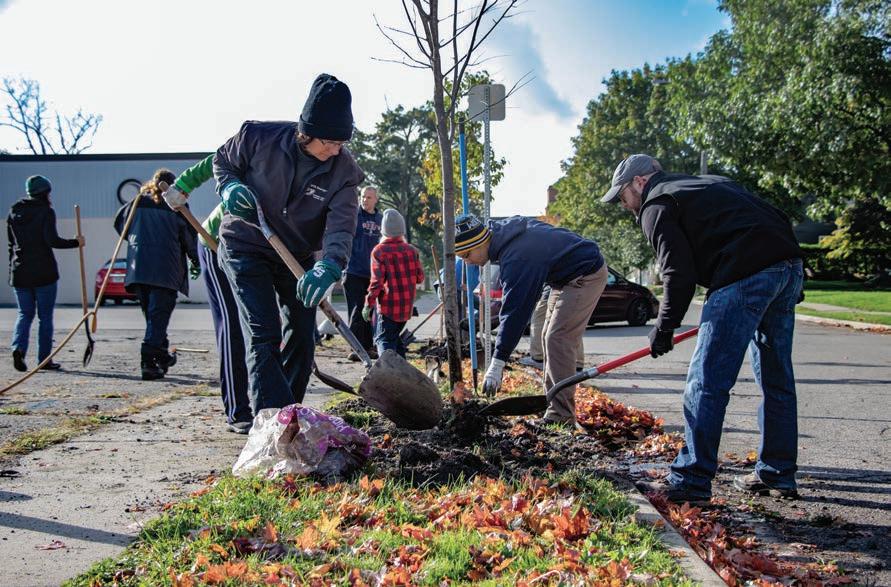
a year later,” says the retired Army Major, who worked on the Bradley Fighting vehicle and M-1 Abrams tank.
The thousands of trees counted include street trees planted between the sidewalk and curb in front of homes, trees in public areas like traffic islands, those in parks and around city hall, along with trees in historic Riverside Cemetery located behind 35th District Court.
The next step was to physically tag those trees, which Gerlach says is an ongoing effort that uses KPL volunteers.
“We have a lot of locations that have multiple trees and so to be able to accurately know what tree we are talking about, it’s helpful to have a physical identifier to allow the tree to be more easily identified,” says Burrows, who added that so far, all park trees have been tagged.
We often take them for granted—the silent giants that grace our streets, parks, cemeteries, and backyards. Trees not only add beauty and shade, but they also enhance our outdoor spaces in ways we don’t always appreciate. In Plymouth, a growing partnership between the nonprofit Keep Plymouth Leafy and the city is ensuring that our green canopy is being catalogued, nurtured, and renewed for generations to come.
It all started with former City Commissioner and Mayor Pro Tem Kelly O’Donnell, who started Keep Plymouth Leafy (KPL) with the help of neighbors in 2017 as a way to grow and maintain the city’s tree canopy and enhance its tree-lined streets and parks.
“One of the driving factors for why KPL was created was because of the loss of trees from various aspects, such as a street
project, home construction, new water main, sewer work, or repaving roads,” explains Adam Gerlach, assistant director of Municipal Services.
“Those activities affect trees on the streets and one of the issues that we have in planting new trees is cost of trees themselves. Kelly and I had some discussions about the need to gather grant funds and organize volunteer efforts to plant trees due to loss and that is when KPL was born,” adds the Plymouth resident, calling himself the bridge between the city and KPL.
Since its founding, KPL volunteers have planted about 400 trees in the city, according to O’Donnell. They’ve also undertaken the arduous job of a tree inventory.
“We partnered with KPL back in 2017 and 2018, as we
were trying to figure out how many trees we apply for through various grants,” says Gerlach. “We were looking where we should plant them and how many we needed. It seems like a simple answer, but there’s more to it than you think -- that’s how the inventory was born.”
Figuring out how many areas needed trees and what trees to plant, along with documenting the condition of current trees was no small job, especially since the last tree census was completed in the late 1990s and existed only as a paper copy.
That’s where KPL volunteer and Plymouth resident Jim Burrows got involved.
“We started thinking about how to do the inventory in late 2018. There were about 10 volunteers. We walked the streets with clipboards and updated the inventory. We did that through 2019 and finished up about
Now that trees are in full foliage, KPL volunteers will continue tagging trees along the street and other areas. So don’t be surprised if you see a volunteer tagging a tree in front of your property this summer. Volunteers usually


Cleaning the air, reducing water runoff, beautifying the environment, maintaining property values and supporting economic activity downtown. There is lots of research out there for all the benefits trees provide.
Adam Gerlach, assistant director of City of Plymouth Municipal Services

carry a clipboard and wear a badge provided by Planning & Community Development Director Greta Bolhuis.
“When we nail tags into trees, people often stop us and ask what we are doing, so the badges really help,” says Burrows, whose degree in geography and expertise in mapping has been invaluable for KPL.
Tagging makes it easier to identify specific trees that are damaged or diseased, so that Municipal Services can take appropriate action, including planting new trees.
While trees bring a pleasing aesthetic to just about any outdoor space, there are many practical reasons that Municipal Services has been planting trees for years.
“Cleaning the air, reducing water runoff, beautifying the


include individuals, families as well as the Margaret Dunning Foundation, Kiwanis Club of Plymouth, Bosch Community Fund and Wilcox Foundation.
As we walk beneath their branches or enjoy their quiet shade, it’s easy to forget the care trees need to thrive. Thanks to the efforts of Keep Plymouth Leafy and the city, Plymouth’s tree canopy is getting the attention it deserves, enhancing our lives and landscapes for years to come.
environment, maintaining property values and supporting economic activity downtown. There is lots of research out there for all the benefits trees provide,” says Gerlach.
Those benefits are a reason
the City has partnered with the Arbor Day Foundation to implement the Community Canopy program, which Gerlach says fills a gap with the tree program and helps with more aspects of the urban forest.
“We’ve got KPL helping out with various aspects of trees on public property and we have various ordinances that protect trees on public property. We don’t have as much help with private property,” he says. “The Arbor Day partnership is one way of targeting private property’s loss of trees through storms and construction.”
The program is limited to 100 trees per season and provides large trees at no cost to residents for planting on their property. Recipients can use the Foundation’s online mapping tool to identify the best planting location that will reap all the benefits of their tree. Many of the trees were picked up in May, while others were directly shipped.
There are also programs to receive a free tree for planting in the right-of-way through the
city and KPL, with all property owners eligible to participate. Supplies are based on available funding and recipients are selected on a first-come, firstserved basis. Either city staff or a contractor of the city will plant the trees, adds Gerlach.
Forms for free trees are available on the city’s municipal services department web page (www.plymouthmi.gov), as well as the Keep Plymouth Leafy website (keepplymouthleafy.org).
Other efforts to maintain Plymouth’s leafy-ness include “tree blitzes” or a planting day where Municipal Services targets an area where there are bigger needs, such as 3-4 houses in a row that need street trees, Gerlach adds.
KPL coordinates with the city for tree blitzes in the local parks, with the city providing tools including shovels, rakes, wheelbarrows and mulch. Tree blitzes happen monthly between May and September. Check keepplymouthleafy.org/ for blitz dates and how to get involved or donate. KPL supporters
For more information about Keep Plymouth Leafy, including how city residents can get free trees through the group, visit keepplymouthleafy.org.
There are a couple upcoming opportunities to help care for the trees in local parks. Join members of the non-profit Keep Plymouth Leafy from 6-7 p.m. on September 2 at Knights of Columbus Park (Old Village Firehouse) and October 7 at Hough Park. The City of Plymouth will provide mulch and tools, and volunteers will spread the mulch around the base of the trees. This protects them from drought, lawnmowers and critters. And makes the park look great, too!
For more information, contact our Park Tree Blitz coordinator Robert Hurley at hurlman66@gmail.com.
The Rock | 25


just gently clean it, and once we decided it needed something else that’s when we went to the new bronze (paint). I think it really did wonderfully. We found it at a new facility in Plymouth, Monarch Paints.”
And for people who enter the museum itself, they can check out the newly refurbished Main Street tile, a project completed by Mike Murdie’s Camelot Installations.
The original tile was installed when the museum opened in the 1970s, Kerstens said. In recent years, that tiling became offcolor and “really ugly,” enough to warrant the makeover, she continued.
No more will those pedestrians or motorists making their way past the Plymouth Historical Museum scratch their heads when looking at the murals on the Main Street side of the building.
The reason for brand new clarity is the handiwork of Pete Smith, of Livonia-based The PaintSmith. He recently scrubbed, buffed and re-touched the murals as part of a grant from the Margaret Dunning Foundation.
“They’ll be able to understand what it is, because for a long time it was just a big, flat, dark brown square,” Smith said. “And you couldn’t tell what it was unless you got right up to it and you could investigate.”
But now, with the 1994 mural now brightened and enhanced to 2025 standards, he added that “people started to say ‘Oh my god, I never knew there was a cat and mouse in that one.’ Or,

‘There’s a lady over here,’ or the name of the railroad. It was great to hear stuff like that.”
Elizabeth Kerstens, Plymouth Historical Museum executive director, said the mural project – and a second project to redo tiles along the museum’s indoor Main Street portion, also funded by a Dunning grant – is really a welcome sight as the museum re-opened Aug. 13 following a six-week shutdown during renovations.
Both projects were included in the $30,000 grant from the Dunning foundation, founded in 1997 to support educational and charitable endeavors in western Wayne County.
Thanks to the work done by Smith and Christian Kouzikas (also of The PaintSmith), bystanders now can see original scenes – one featuring a blacksmith farm setting and
the other a train arriving at the Starkweather Road depot. Murals are located on either side of the Main Street entrance.
“They are about 30 years old and they are made of plaster with a bronze coating. So the intention was for them to age. But the problem was they didn’t age like typical bronze does. It just got dark,” Kerstens said. “When I saw them after Pete had added the metallic rub, I was just astounded at how beautiful they are. Now you can see what they are.”
To start the project, which took about a week to complete, they used soft brushes to tackle years of dirt and grime, to not do damage to the original murals. They soon decided the project needed a new approach.
“We couldn’t just scrub it up, especially since it hung there since 1994,” Smith noted. “It doesn’t sound like it’s a long time ago, but it was. We were able to
“Going down the middle of our Main Street looks like brick,” Kerstens said. “On one side it looks like cobblestone. So what we’ve replaced it with, all along our Main Street and into the Victorian area, is tile that looks like dirt with rocks in it, stones in it. Like you’re walking on a dirt surface.”
Kerstens said the summer projects aren’t all that is happening at the Plymouth Historical Museum.
Now open, through Dec. 31, is a new exhibit dubbed “The Fair That Changed America.” The exhibit will detail the 1893 Chicago World’s Fair, aka the Columbian Exposition.
“This exhibit we like because it showcases some really significant changes to American culture at the end of the 19th century,” Kerstens stressed. “And, that are still apparent today, that led to a lot of things that are around today. Like dishwashers.”
The Plymouth Historical Museum is located at 155 S. Main Street. Hours are 1-4 p.m. Wednesday, Friday, Saturday and Sunday. For more information, go to plymouthhistory.org or call (734) 455-8940.







My mother has macular degeneration and her vision has At this point, she can’t drive and struggles to watch television and read. Is there anything to help her function better?
My mother has macular degeneration and her vision has continued to worsen. At this point, she can’t drive and struggles to watch television and read. Is there anything to help her function better?



Depending on her sight, driving may still be a possibility. Usually the bigger goals include tasks like seeing faces, photos and reading so she doesn’t become isolated and can maintain some independence. Holding magnifiers and using a closed circuit television is cumbersome and fatiguing, and eventually most people give up. You will find our hands-free, custom designed bioptic and telescopic glasses to be a real game changer for her. People who see better live longer with a better quality of life – less chance of becoming depressed, less chance of falling. Like many patients I’ve helped, your mom can also continue to have a fulfilling life.
Depending on her sight, driving may still be a possibility. Usually the bigger goals include tasks like seeing faces, photos and reading so she doesn’t become isolated and can maintain some independence. Holding magnifiers and using a closed circuit television is cumbersome and fatiguing, and eventually most people give up. You will find our hands-free, custom designed bioptic and telescopic glasses to be a real game changer for her. People who see better live longer with a better quality of life – less chance of becoming depressed, less chance of falling. Like many patients I’ve helped, your mom can also continue to have a fulfilling life.

Dr. John P. Jacobi, OD, FCOVD, is the Clinical Director of Suburban Eye Care. For over 25 years, he and his team have been serving patients in the Livonia area. Dr. Jacobi is a Fellow of the College of Vision Development and the International Academy of Low Vision Specialists, a member of the Michigan and American Optometric Associations.

Dr. John P. Jacobi, OD, FCOVD has been serving patients in Livonia and the surrounding area for over 25 years. Dr. Jacobi is a Fellow of the College of Vision Development and the International Academy of Low Vision Specialists, a member of the Michigan and American Optometric Associations.


Storytelling, education and music. In so many ways, these ideas are deeply intertwined. Music tells stories; stories educate people; and together they can enrich our lives, often bringing people together no matter the age or background.
For many, this cultural trio of music, story and learning seems pretty obvious. But for Joan Walton, the new executive director of the Plymouthbased Michigan Philharmonic Orchestra, they truly are values to live by, work for and to share.
For much of her career, Walton has focused on advocating for the ideals of educating people, training people, and sharing stories. While her direct impact on music in the community may
not be as great as her previous roles in the metro Detroit arts community, educating young
Philharmonic’s 80th season of presenting music in Plymouth and across the region.
“I wanted to get back into the arts. I want to help bring joy and passion to what I do and love what I’m doing. That really resonates with people, with the patrons and the staff and the funders. That love, that excitement makes a huge difference.”
Joan Walton, new executive director of the Michigan Philharmonic
and old alike or helping those in need, she knows making a difference matters.
And that’s important, especially since this is the
education or the arts like music, I think we are at a point with the arts and its funding that my role is to be an advocate for the Philharmonic.”
Being an advocate blends those things she loves –education, telling the stories of organizations she cares about and creating a vibrant passion for culture that draw and keep people engaged in a community.
“It’s impactful storytelling really,” says Walton. “Reminding the community of what the Phil is and what it does and how it makes the community feel alive.”
Walton, who grew up in Detroit and began her career at the Ford Motor Company as an “instructional designer,” sees Plymouth as a vibrant community partially because people care so much for things like the symphony,
“I wanted to get back into the arts,” she says. “I want to help bring joy and passion to what I do and love what I’m doing. That really resonates with people, with the patrons and the staff and the funders. That love, that excitement makes a huge difference.”
Prior to taking the position at the Philharmonic, Walton was the director of community and volunteer engagement for Zaman International, a nonprofit, humanitarian organization committed to addressing the basic needs of marginalized people and supporting the U.S. State Department’s “Welcome Corps” that helps refugees.

“I think what’s really at the core of everything I’ve done is about advocacy,” says the 59-year-old Huntington Woods resident. “Whether its kids’
When that program was canceled earlier this year, Walton saw an opportunity to return to the arts community. She spent nearly 14 years with the Detroit Institute of Arts (DIA) and then five years with the Belle Isle Conservancy before joining Gleaners Community Food Bank and eventually Zaman.
“I know education can be

impactful,” she says. “I’m a mom and my daughter was blessed to be in the band so I know that music is important, as well. I can be a champion and when I get excited about things I want others to be excited, too. Even if the work is hard--and this work is hard-it's good. It’s good for the soul, for the community, for ourselves.”
Walton began her career after getting a degree from

Wayne State University in political science. She considered law, but she moved to New York, where she joined a dispute resolution organization with other college grads and law students. One day her boss mentioned the organization had an office in Detroit and invited her to return to Michigan and help here.
“I thought about law school, but I liked the nonprofit world a lot,” she says. “I found a master’s in education program at Wayne State that focused on training and education and that resonated with me. I got into corporate training and veered off to developing people.”
With a master’s degree in instructional design, she went to work for Ford where she spent four years managing the development of a 14-course curriculum to help managers train their teams.
“Corporate life wasn’t for me,” she says. “I veered off again and found a niche at the DIA doing education programs, mostly for K-12 students.”
Greece or Peru.
“Sometimes it’s fun to travel alone, then you don’t have to worry about anyone else, just yourself,” she says.
She developed education programs at the DIA and later at the Belle Isle Conservancy as the associate director of education, facilitating the re-design of the interpretive signage at the Belle Isle Aquarium and the Anna Scripps Whitcomb Conservancy. She left the conservancy for Gleaners and also briefly worked at the Detroit Zoo as a volunteer services manager.
“My biggest impact may have been at the DIA, helping get the millage passed that would ensure support of the museum in the counties,” she says. “I had a key role in that and that may be my longest lasting contribution as a leader.”
Later, during three years at Gleaners she helped coordinate volunteers at more than 60 mobile food distribution sites during the height of the pandemic.
“Helping feed people during that global pandemic probably actually trumps the DIA work,” she adds.
Walton, who considers herself a die-hard Detroit Tigers fan, knows a bit about Plymouth, having met her husband Mark in the community.
“He lived here and we’d go to the movies at the Penn Theater,” she says.
The Waltons have been married for 34 years and have a daughter Julia, who lives in Washington D.C. They play pickleball and also love to travel. Walton sometimes likes to venture out on her own with solo trips to places like Morocco (she’s on an adventure there this month),
Highly organized and a project manager at heart, Walton says she is a doer, an optimist and likes to bring a sense of humor to a role. She only wants to cry when “I’m laughing too hard.”
As leader of the Philharmonic, Walton wants to focus on being a champion and a good steward.
“I learned early on that nonprofits need to run like a business,” she says. “This is what funders and supporters want to see. They don’t want a lemonade stand, but a business that understands its patrons and is careful with its funding.
“Let’s face it, we need money to do what we do,” she says. “It needs to be diverse and handled carefully. Some nonprofits don’t want to think this way. I bring that and my passion and joy and love of what I’m doing. If I’m not having a good time I’m not in the right place. When it needs to get done we’ll do it. There’s no hand-wringing, no anger and just a need to figure it out.”
Walton has also figured out that cultural activities offered by organization like the Philharmonic are what attract and keep people in a community.
“It’s schools, arts and culture and walkable communities,” she says. “That’s what a lot of people are looking for. This state needs to do a better job with all that.”
But perhaps that is another story altogether.
The Michigan Philharmonic launches its 80th music season next month. For more information, including how to purchase tickets, visit www. michiganphil.org.

Beth Stewart, the longtime executive director of the Michigan Philharmonic, and a stalwart leader in the Plymouth community, is retiring from her role as leader of the 80-yearold cultural organization.
Stewart, who has lived in the community for nearly five decades, led the Philharmonic for 17 years, taking on the role after leaving the Plymouth Historical Museum where she was the executive director for nearly 20 years.
A well-recognized leader in the community, Stewart has been president of the Rotary Club of Plymouth AM two times and served on the board of the Motor Cities Auto National Heritage Area, the Wayne County Council for Arts and been a longtime volunteer with the Salvation Army and Plymouth-Canton Schools.
The Lakepointe neighborhood resident says she hopes to enjoy more time with her grandchildren and her daughters. She also loves to garden, taking part in community events and activities like the Fourth of July parade and supporting the Plymouth Chamber of Commerce.
Stewart brought a high-level of organization, dedication and devotion to her role, helping expand the Phil’s many programs, especially education activities, fundraising and community awareness.
At one time or another, she has done it all for the Phil (except maybe get on stage and play an instrument or conduct). Her extensive background in arts, history and fundraising helped the organization as it grew from a small community orchestra to a fully professional regional orchestra performing in multiple venues across southeast Michigan.
Her work facilitated the growth of the educational outreach program into six local school districts. She founded the Friends of the Phil membership group and organized the Michigan Philharmonic Travel Group which has taken a dozen trips to Europe.
Stewart was named a Ruth Hutson Whipple award winner for community engagement in Plymouth and has been inducted into the Plymouth Hall of Fame.
So long Beth Stewart! You will be missed.

